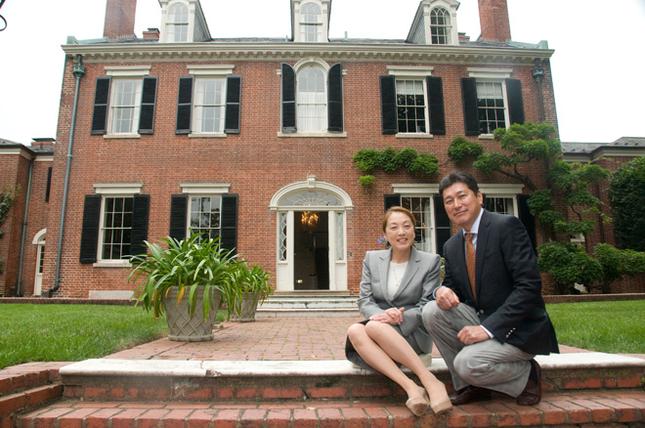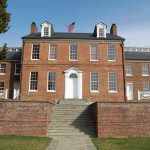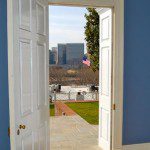Ueno & Kuno: Scientists’ Artistic Formula
By • September 12, 2013 0 2477

When biotech scientists Ryuji Ueno and Sachiko Kuno made headlines two years ago, local observers did not know what to make of them.
The married couple made a big splash in terms of luxe, Federal-style real estate: buying the Evermay estate on 28th Street in 2011 and Halcyon House on Prospect Street in March 2012. Georgetowners, ever aware of history and real estate, wanted to know: who are these pharmaceutical millionaires from Japan by way of Bethesda and what are these entrepreneurs doing in the most storied, oldest neighborhood in Washington, D.C.?
“There’s nothing to hide,” said Kuno, along with her husband, to one last question during an interview with the Georgetowner at Evermay last month.
They have lived in Potomac or Georgetown since the mid-1990s and are not so “mysterious” anymore, as one newspaper article tagged them last year. We know they founded Sucampo Pharmaceuticals in Bethesda and made millions of dollars, after approval by the Food and Drug Administration, on patented drugs that fight gastrointestinal problems, especially constipation, and, earlier during their work in Japan, eyedrops that treat glaucoma.
Ueno earned a medical degree along with other doctorate degrees. A biochemical engineer, Kuno holds several Ph.Ds. Because of this, those who work with them simply call them “the doctors.” Before they became a couple, the two worked together in Japan and then here. A second marriage for both, Ueno, 59, and Kuno, 58, married in 2002.
While remaining their reserved selves, the couple knows they are more public figures than ever before, especially when talking about the S&R Foundation which they founded in 2000. They are benefactors to the Cherry Blossom Festival, the Washington National Opera and the Smithsonian.
Theirs is an American story with a Washington theme that has played out before. Immigrant or not, inventors and innovators have come here to be near federal government agencies that approve as well as advise on new products. Consider why Alexander Graham Bell moved here and lived in Georgetown.
Ueno said that they decided on D.C. because the FDA, National Institutes of Health as well as the Patent Office are here. Sucampo Pharmaceuticals holds hundreds of exclusive patents. Both said they liked D.C. for its historic sites as well as its weather being similar to Japan.
“I love Washington, D.C., because it is an international city and a good size and historical,” Kuno said.
But the reason for all of it, really, appears to be the S&R Foundation, which takes its initials from the first names of Kuno and Ueno. Its offices are now at Evermay on 28th Street, N.W. Its mission is ambitious: “to support talented individuals with great potential and high aspirations in the arts and sciences, especially those who are furthering international cultural collaboration.”
“We were looking for a venue for the foundation,” said Kuno, its CEO. “We asked Mark McFadden,” a friend and real estate agent who handled the P Street house sale in 1996. (They sold that home a few months ago.) McFadden showed them Evermay in May 2011.
“Both of us fell in love with Evermay,” Kuno recalled. “In five to ten minutes, we made a decision [to buy it for $22 million]. Later, McFadden showed them Halcyon House. In 2012, it was theirs for $11 million in cash.
Both historic properties sold for half their original asking price: Evermay (1801) by the Belin family with gardens and three-and-a-half acres; the more urban Halcyon House (circa 1785) by the Dreyfuss family with twice as much interior space as Evermay.
Evermay holds many of the musical events for the S&R Foundation, while Halcyon House is being prepped for seminars and more for its global resilience programs.
According to the foundation, Halcyon House will have 40 meetings per year with fewer than 50 persons among other events.
“Neighbors are particularly concerned about traffic and parking issues associated with the proposed Halcyon events, and it is imperative that the new ownership resolve these concerns,” said Jeff Jones, an advisory neighborhood commissioner.
The foundation will meet with Georgetown’s ANC Sept. 3 and the D.C. Board of Zoning Adjustment Sept. 10 on how it plans to deal with events at Halcyon House and the surrounding neighborhood. Last year, it did the same and got approvals for Evermay.
“Evermay is everyone’s treasure,” Kuno said. “Halcyon House is the same thing. The preservation of Halcyon House is our mission and our responsibility as new owners. At the same time, if we can use Halcyon House together with our neighbors, it would be great. … We talk to neighbors to find a solution. Halcyon House has great potential.”
For some, it simply comes down to parking: it is a D.C. — especially Georgetown — thing. Events in town take away spots for nearby residents.
S&R Foundation attorney Alice Haase said the group is tailoring events to discourage parking near Halcyon House. “Street parking is never encouraged,” she said. “In fact, it is discouraged.” Haase has scheduled another meeting with Halcyon House neighbors for next week.
As it happens, the goals of Kuno and Ueno for the S&R Foundation go far beyond the problems of event management. The foundation is made up of several parts.
Its popular Overtures Series will host recitals at Evermay each of the four Friday evenings this September — two of which feature Canadian pianist Ryo Yanagitani, who has played and stayed at Evermay before.
With the Kyoto-D.C. Global Career Development Program, the foundation partners with Kyoto University to bring Japanese students to D.C. for a few weeks to learn about working in international organizations, such as NASA, the World Bank or NIH.
S&R has also begun its Illuminate program, which promotes and discusses the ideas of young entrepreneurs. On Aug. 22, Illuminate hosts the Millennial Train Project, a transcontinental journey of personal growth, and RocksBox, a jewelry subscription service. The foundation’s chief operating officer Kate Goodall views Illuminate as “a 21st-century salon,” which will be politically neutral as well as being “brave, innovative and engaging.”
The International Institute of Global Resilience, according to S&R, which launched in December 2012, is “a think tank dedicated to improving the readiness of the emergency management community through research and education” and will become a bigger player for the foundation. It is headquartered at Halcyon House.
“In founding this foundation, Ryuji and I looked back to our experience,” Kuno said. “We grew our company with a lot of support from the American people, including our neighbors in Bethesda and Washington, D.C. We like to return [such help] to the next generation. The reason we selected art as a major part for the foundation to support is that artists and scientists need to have inspiration and creativity. Both are so similar to each other.”
Is that how music led the way for the foundation? It was the husband not the wife who pushed the musical side with the ongoing Overtures Series. “I am the second generation to support what my father has done,” said Ueno, who has two sons from his first marriage. “He was crazy about music, especially chamber [and classical] music. He was a collector of musical instruments.” When Ueno spoke of his father, he became more animated, letting go of some of his formality. He reads music and plays the flute.
In Japan, Ueno’s father started a chemical company; his grandfather had an automobile company. “My father was an inventor,” Ueno said. “My grandfather was an inventor. I was born and raised in an inventor family.” His wealthy family hails from near Osaka.
What does a biotech tycoon do to relax? Besides houses, Ueno collects and restores cars. He reportedly owns about 60 and is building a garage for a few at Evermay. He likes the Ferrari Dino of the 1970s. “I love the design of the Corvette Stingray,” Kuno said.
Nowadays, their two golden retrievers, which they got as puppies at an Ambassadors Ball auction, determine the ride. The dogs grew too large for the Maserati, then too big for the Jaguar, Ueno said. Mario and Cherry ride in a Volkswagen Passat and might bark for a ride to family homes on the Eastern Shore, especially one in St. Michael’s, Md. Still, one of the household’s last very old cats, June from Japan, lives on.
Asked for vacation spots, the conscientious couple named Oxford and Kyoto, places with major universities. O.K., how about a favorite spot to eat in Georgetown? Bistrot Lepic, they allowed.
So, what was that last question asked? It was: what should Georgetowners know that they might not know about you?
Upon reflection, it was answered by Kuno: “I am very lucky that I was one of six female students of thousands at Kyoto University [30 years ago]. My professors and my parents were very supportive. They encouraged me. It was a unique opportunity for a women like me to go to Munich [to study].”
It is also Kuno who takes this life lesson to heart, and it is at the heart of the S&R Foundation: to give young persons opportunities and challenges. That is the heart of the story: Like the two cherry saplings from the Tidal Basin, growing at Evermay, in a circle of life, Japan to the U.S., back again and yet together.
Full disclosure: the author lived in Halcyon House from 2005 to 2012.
- Doctors Sachiko Kuno and Ryuji Ueno in the back of the Evermay estate on 28th Street, previously owned by the Belin family, now headquarters for the S&R Foundation. | Isabel “Didi” Cutler.




